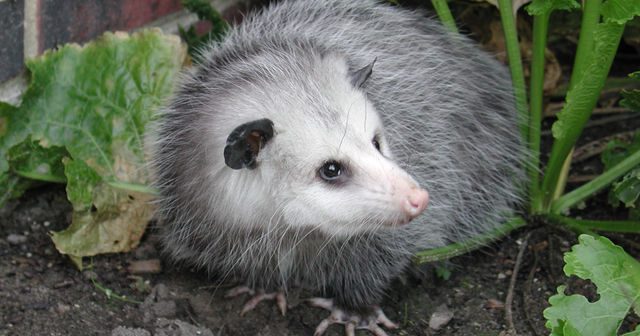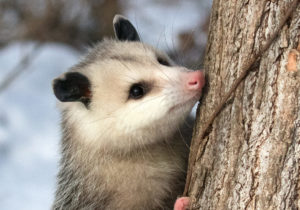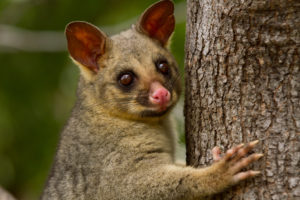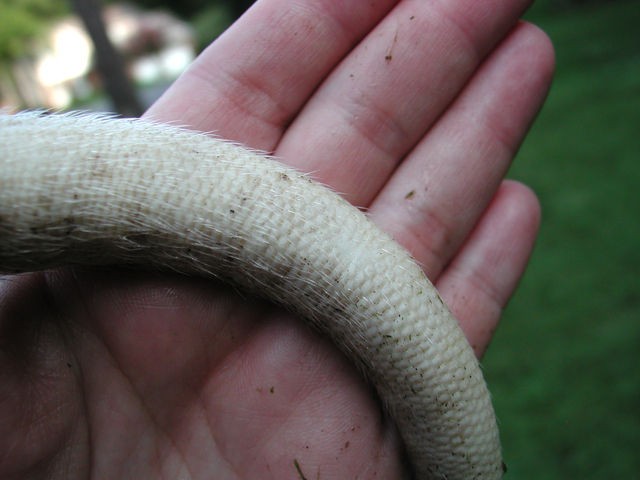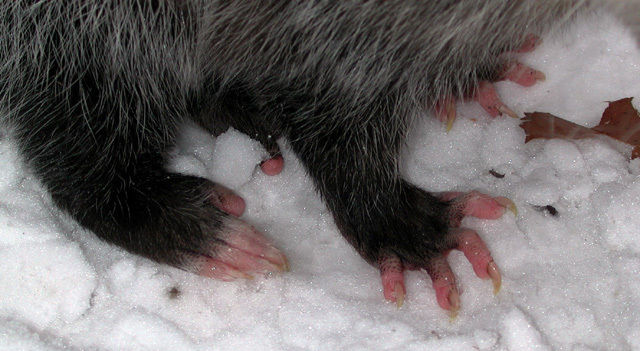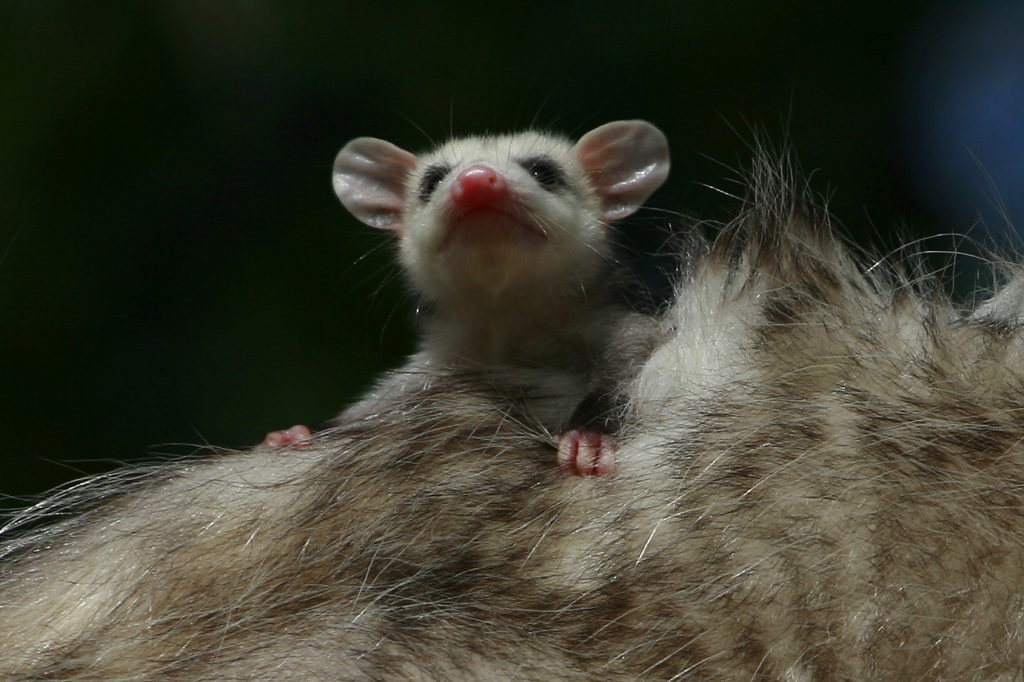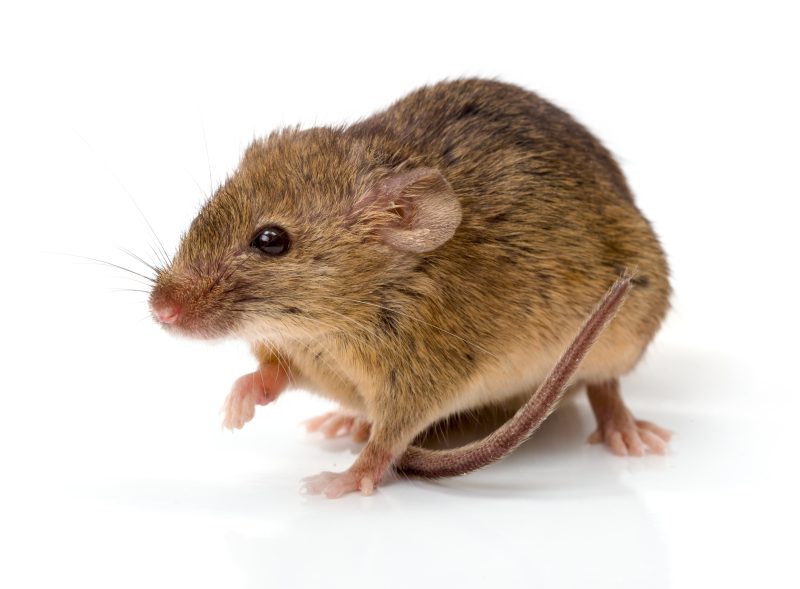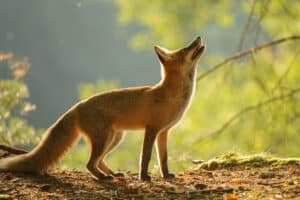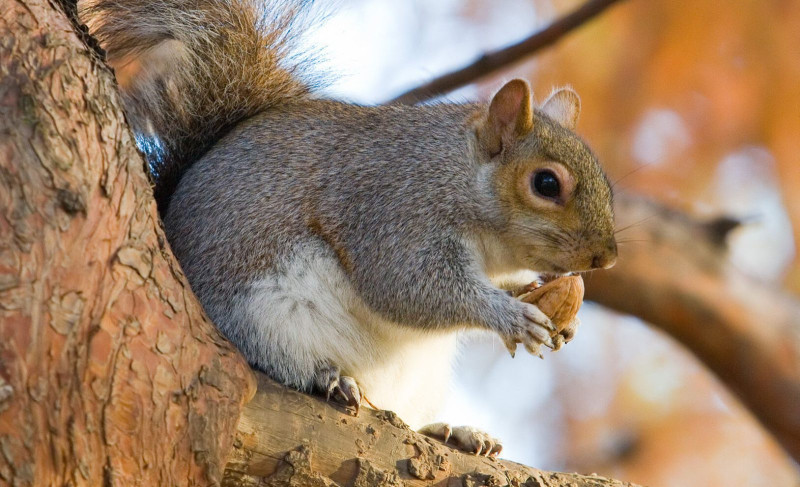Be kind to Virginia Opossums. They have a wicked hiss and a mouthful of teeth they’ll flash when scared, but they’re actually sweet-tempered and don’t bite unless forced to. And they never have rabies.
The Virginia Opossum is the ideal visitor to your yard. It’s quiet and doesn’t pick fights or leave foul odors. Nor does it dig or claw. Instead, it shuffles in, eats a rodent, scarfs down some insects and snails, munches on fallen fruit, and cleans up any leftovers in the dog food bowl. Then it lumbers away. That’s it! They get unfairly blamed for damage done by other animals.
Background
Opossums have existed since the Pliocene Epoch, two to five million years ago. They’ve endured the passage of time astonishingly well and essentially unchanged. How? Scientists aren’t sure but think it’s because they’re masters of adaptation. Change their habitat, and they adjust to a new one. Denied their usual food sources, they change their diet.
Opossums are marsupials, mammals that undergo the early part of their development in their mother’s womb and the rest in her pouch. Other marsupials include kangaroos, koalas, wombats, wallabies, Tasmanian Devils, and … “possums.” That isn’t a misprint. Opossums aren’t possums, although they’re often called that in the United States. Except for also being marsupials, the possums are a group of entirely different animals in the family Phalangeridae and inhabit Australia and surrounding islands.
There are 60 opossum (oh-POSS-um) species in the world, most of which inhabit Mexico and Central America. Only one, the Virginia Opossum, inhabits the United States, where it’s found along the West Coast and throughout the country’s eastern half. European colonists first discovered the Virginia Opossum in, yes, Virginia.
The Virginia Opossum, Didelphis virginiana, is in the order Didelphimorphia and the family Didelphidae. Its genus name Didelphis is Ancient Greek for “double womb.” As you read on, you’ll see how appropriate that is. “Opossum” comes from apasum, an Algonquin Indian word for “white animal.”
Physical characteristics
Virginia Opossums are 2–3 feet (61–91 cm) long, plus a tail length of 8–13 (20–33 cm) inches. Sources vary widely about their weight, with some reporting a range of 4.6–6.2 pounds (2.1 to 2.8 kg) and others as high as 8.8–13.2 pounds (4–6 kg). Males are usually larger than females.
The Virginia Opossum has a long, pointed face with black eyes, long whiskers, and a distinctive pink nose. Its ears are hairless, black, and tipped or edged with white. White hair covers its face, and its body is a sparse, coarse grizzle of grayish and blackish hair. Its thin hair makes it susceptible to frostbite, so it doesn’t inhabit regions that get very cold.
When it opens its mouth, you see how sharp and dangerous its teeth look. There are 50 in all, the most of any land mammal in the U.S. But don’t let that fool you. Opossums are mild-mannered unless deliberately provoked, and sometimes not even then. They just want to scare you into stepping away. If you’re in doubt, watch this.
The tail is prehensile, meaning it’s hairless, scaly-looking, long, and used for grasping things. You may have heard that opossums hang by it, but that isn’t so. Very young ones might sometimes do that, but adults are too heavy. In fact, being lifted by the tail is painful.
Their feet, bare on the bottom, have five hairless, dexterous toes (some experts call them fingers). Each of the hind feet has a thumb, called a hallux. All their toes are clawed except for the thumbs, which are used to grasp branches when climbing.
Opossums are fastidious and lick themselves constantly. The licking, at least in part, regulates their body temperature—they lack sweat glands, and the evaporating saliva helps to cool them.
Senses
Their sense of smell is exceptional–they have 1,188 genes devoted to smell. (By comparison, humans have 396 olfactory genes.)1 Their eyesight is poor, however, and their senses of hearing and taste are relatively weak, too. But they have a keen sense of touch.
Communication
Virginia Opossums make only a few distinct vocalizations. They hiss, snarl, and screech and may do all of these when showing aggression. Clicking sounds also are made by males during mating behavior, by females around their young, and by babies. Some sources say mothers make a purring sound to their young. Listen to opossum baby making clicking sounds
Intelligence
Opossums have a reputation for being dim-witted because they move slowly and have a small brain size (five times smaller than a raccoon’s). However, researchers found in a series of tests that they’re better than dogs, cats, and other animals at remembering the location of food hidden in a maze–only humans were superior. And, owners of young rescued, un-releasable wild opossums say they can be litter box- and leash-trained, love to be held and to snuggle, and will greet them at the door when they return home. They also claim that opossums come when their name is called.2
Behavior
Virginia Opossums are solitary except when mating or caring for young. They’re strictly nocturnal, except in winter, when they’re sometimes active in the daytime on warm days.
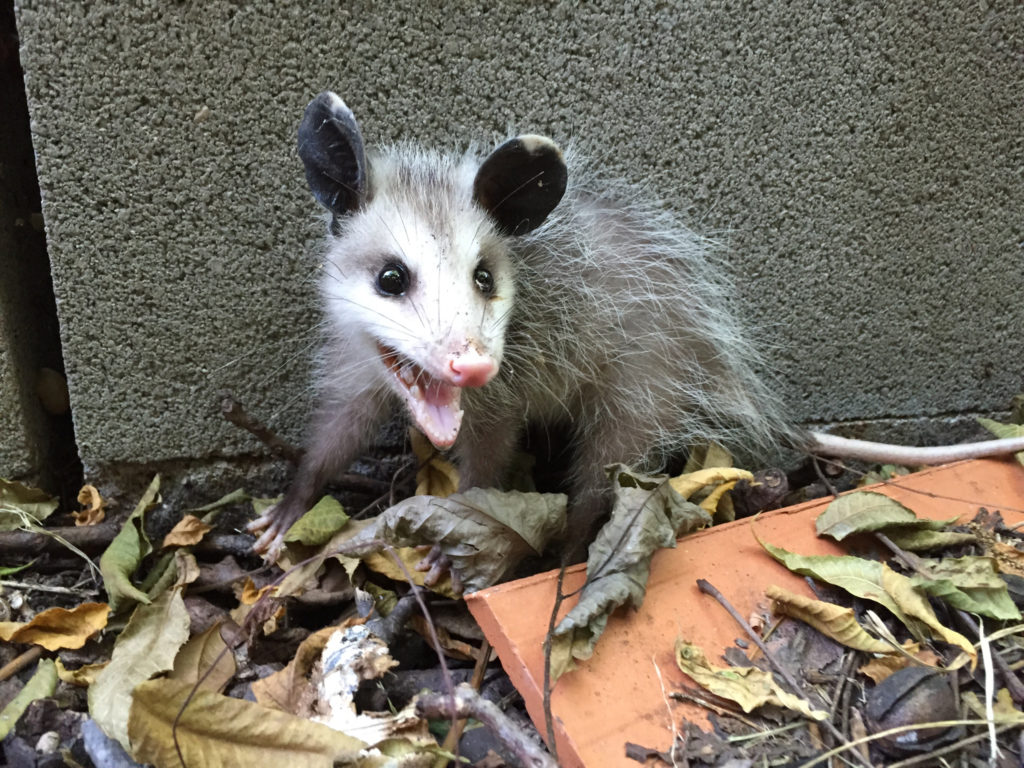
Opossums try to seem very dangerous by flashing their teeth and hissing—even young ones like this. (rgrichie, iNaturalist / EOL; CC BY-NC 4.0)
They move in a slow, swaying waddle, but if circumstances compel them, they can run four miles per hour (6.4 km/h). But that’s equivalent to a fast walk for a human and won’t save them from most predators on a straightaway. So, they may scale a tree (they’re good climbers), skinny into a woodpile or den, or dive into water (they’re able swimmers). They may try to bluff their way out of trouble with a flash of teeth and scary hissing and snarling. Or, they may just drop “dead.”
Playing ‘possom
Virginia Opossums are well-known for pretending to be dead, or “playing possum,” but it isn’t an act. Instead, feigning death is an involuntary, stress-induced nervous collapse, and it’s convincing:
The opossum falls on its side and lies quite still with its body curled. Its mouth opens in a grimace, its tongue hangs out, it drools copiously and stares with unmoving eyes. It may defecate or discharge a foul-smelling fluid from its anal glands. It doesn’t respond to sound or prodding. It’s impressive, and predators that don’t eat dead meat will often move on. This catatonia-like state may last minutes or hours. Eventually, the opossum awakens, gets up, and goes about its activities with no ill effects.
Reproduction
Females reach sexual maturity at about seven months and can breed about every 28 days year-round. Peak time, though, is late December through January (February in northern areas) and, to a lesser extent, from mid-May to early July. After mating, males go on their way and don’t participate in raising the young.
Females typically mate only once or twice a year, each time having eight to 12 young. Their reproductive system is bifid, meaning there are two sets of reproductive organs. (The male’s penis is also bifid). Some of the fetuses develop in the left uterus, and others in the right. Like cars merging into a single traffic lane, the fetuses are born one by one through a birth canal called the median vagina. Gestation lasts only 12 or 13 days. After that, the young continue their development in their mother’s pouch (marsupium).
But first, they must perform a harrowing journey to get there. The newborns are the size of a bee and weigh 1/200th of an ounce (0.1 g). Hairless and nearly transparent, they aren’t much more than embryos. Their mother prepares the way by licking a path through her hair. They follow this with a swimming motion, pulling themselves blindly up the slope of her belly to the pouch. The trek is only three or four inches long, but for these little guys, it’s monumental. Treacherous, too. A sudden move by their mother and they’ll fall off and perish. The weaker babies will not make it, regardless.
Those who make it to the fur-lined marsupium will suckle from one of 13 teats aligned in a horseshoe arrangement. This is their lifeline to further physical development, and they hang on tightly. If there are more than 13, the extra ones will die.
Two months later and the size of a mouse, babies have begun to outgrow their warm, protected environment that’s now stretched nearly to its limit. Ever so cautiously, they peek out. Then they duck back inside. They peek out. They pull back inside. They’ll do this many times over the next couple of weeks until they finally climb out–still clinging to their teat! They’ll stretch just as far as possible but won’t turn loose.
Eventually, in a tense moment of bravery, they open their mouths and let go. Then comes the second significant climb of their lives: up to their mother’s back (not her tail, contrary to myth), where they tightly grasp her hair with their toes and tail. If any fall off, they make hissing sounds, and their mother makes clicking sounds in response. If she’s unaware they’re gone, however, she’ll go on without them, and at this young age, they’ll perish.
While hanging on, they travel widely in search of food, lodging, and other tricks of survival as adults. Finally, after a few weeks, they begin life on their own four feet by simply loosening their grip and dropping off. By now, they’re about 7–9 inches (18–23 cm) long, excluding their tail. They share their mother’s den for a short time, then leave to establish territories of their own.
Lifespan
Most Virginia Opossums have short lives. Those in the wild survive only a year or two: Many die because they don’t make it to their mother’s pouch; newly weaned and adult opossums are prey for numerous carnivores; and vehicles take a significant toll, too. In captivity, they live three to four years. It’s rare, but there are reports of captive opossums living for eight to 10 years.
Habitat
Although well adapted to city life, their natural habitat is deciduous forests, but they also are found in farmlands, prairies, and wet areas, such as marshes and streams.
Food sources
You name it; they’ll eat it. In addition to “people food” in the garbage can and pet foods left outdoors, Virginia Opossums eat insects, fruits, grains, nuts, rodents, frogs, the eggs and young of other animals, and carrion.
Cover and nesting
Virginia Opossums generally nest alone, although females sometimes use daytime nests together. Their feet are soft and delicate, with small claws that aren’t designed for digging. So, instead, they look for existing nest sites that will keep them warm and safe, such as old burrows, drainage pipes, hollow logs, old squirrel nests, rock piles, woodpiles, or under a porch. Even a chimney. They line nests with soft, dry materials, like grasses and dried leaves. They gather their nesting materials by mouth and then shove them under their body, where they loop their tail around them for transport.
Predators
Natural enemies of Virginia Opossums include Coyotes, foxes, bobcats, eagles, owls, and other birds of prey—also dogs and cats. Otherwise, vehicles are their biggest enemy. It’s thought that the opossum’s willingness to eat carrion draws them to roadkill, and then, too often, they become roadkill themselves. Hunters and trappers, too, take a toll, but primarily by finding opossums while seeking other game.
Opossums and rabies
The body temperature of the Virginia Opossum is 94 to 97 ºF (33 to 36 °C), which is too low for the rabies virus to survive. Therefore, it’s nearly impossible for it to catch rabies.
Related reading:
1 For the curious: African Elephants have the best sense of smell, with 1,948 olfactory genes.
2 Wildlife cute, but not good pets
Provide cover for wildlife shelter, safety
How to humanely remove wildlife from your yard
All about the Northern Raccoon

